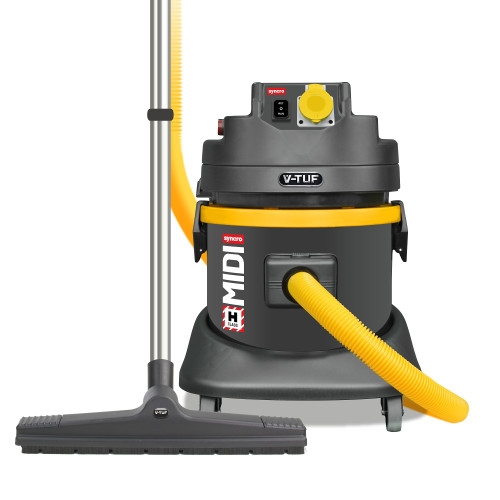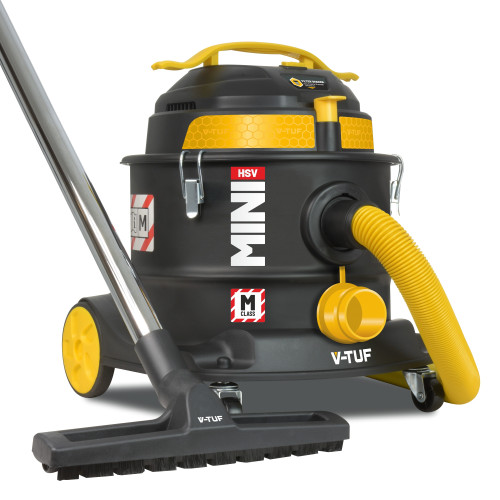Description
The V-TUF MIDI H-Class has H14 HEPA filtration that provides the highest level of protection against seriously harmful dust particles, ensuring a safe working environment for all the workforce.
H Class Filtration is for extracting highly carcinogenic dusts and substances, formaldehyde, mould, germs, lead, nickel, tar and bacteria, so by using a V-TUF dust extraction vacuum cleaner, you are safe to also vacuum materials such as mica, china clay, gypsum, wood dust such as softwood and hardwood, including MDF, silica dust such as masonry, concrete.
The V-TUF MIDI H 110v industrial dust extraction vacuum cleaner features a large 21L capacity, and is supplied with a flexible vacuum hose, and all the tools required for safe vacuuming. This Midi can also be used as a standard wet & dry vacuum cleaner for cleaning non-hazardous liquids and dry goods.
Materials that are broken up, damaged or even disturbed, release fibres harmful particles into the air that have proven to cause serious diseases, when inhaled. Although it may not affect the lungs straight away, and can often take a long time to develop, once diagnosed later in life, it is too late, and has become known as a silent murderer!
By using the V-TUF MIDI H-Class H14 dust extraction vacuum cleaner, you are guaranteed 99.995% filtration from these dangerous airborne particles. In order to remain compliant, you must ALWAYS use the V-TUF MIDIH110 with the H-Class Cartridge Filter (Order Code VTVS7021) – Included, along with the H-Class Filter Bags (Order Code: VTVS7007) – Included, to ensure you are operating up to the required level of safety: H-Class! (Full details on H-Class Safety can be found on the HSE’s website).
Emptying and Cleaning Guide:
Never clean inside the vacuum cleaner yourself if you are not authorised to do so!
• Never attempt to remove or change the bag yourself; this should be done by a competent person under controlled conditions.
• Contact the supplier or a licensed organisation for assistance.
• After each use, clean the vacuum cleaner’s outer casing and attachments with the vacuum and then with damp rags. (Rags must be disposed of with extreme caution).
• Carefully inspect the case, hose and attachments visually.
• Keep the hose and attachments in a clearly labelled plastic sack.
• Replace the sealing cap over the hose opening in the cleaner’s casing with the plug.
• Store in a suitable sealed container until next usage.
Never clean inside the vacuum cleaner yourself if you are not authorised to do so!
• Never attempt to remove or change the bag yourself; this should be done by a competent person under controlled conditions.
• Contact the supplier or a licensed organisation for assistance.
• After each use, clean the vacuum cleaner’s outer casing and attachments with the vacuum and then with damp rags. (Rags must be disposed of with extreme caution).
• Carefully inspect the case, hose and attachments visually.
• Keep the hose and attachments in a clearly labelled plastic sack.
• Replace the sealing cap over the hose opening in the cleaner’s casing with the plug.
• Store in a suitable sealed container until next usage.
Industries:
• Construction, • Tradesmen, • Facilities Management, • Manufacturing, • Contract Cleaners, • Specialists in Hazardous Cleaning, • Glass Removal Specialists.
• Construction, • Tradesmen, • Facilities Management, • Manufacturing, • Contract Cleaners, • Specialists in Hazardous Cleaning, • Glass Removal Specialists.
Areas of Application:
• Dusts Contaminated With Carcinogens, • Dusts Contaminated With Pathogens, • Formaldehyde Extraction, • Mould Extraction, • Germs & Bacteria Extraction, • Roofing Restoration Services, • Floor Restoration Services, • Construction Sites, • All Builders & Tradesmen Working With Hazardous Related Materials, • Building Renovation Services, • Factory Renovation Services, • Swarf Extraction/Removal (Machinery & Material Processing), • Sanding, Drilling, Demolishing, Cutting, Sweeping Silica Dust particulates, • Construction Refurbishment & Fit Out.
• Dusts Contaminated With Carcinogens, • Dusts Contaminated With Pathogens, • Formaldehyde Extraction, • Mould Extraction, • Germs & Bacteria Extraction, • Roofing Restoration Services, • Floor Restoration Services, • Construction Sites, • All Builders & Tradesmen Working With Hazardous Related Materials, • Building Renovation Services, • Factory Renovation Services, • Swarf Extraction/Removal (Machinery & Material Processing), • Sanding, Drilling, Demolishing, Cutting, Sweeping Silica Dust particulates, • Construction Refurbishment & Fit Out.








